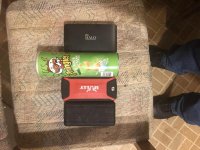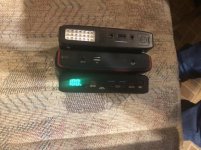IdahoMtnSpyder
Well-known member
I am wanting to charge a RV battery in my Timeout Slipstream camper which I pull with my 2016 RTL. I have run positive & negative wires from the cranking battery to the rear of the bike with a fuse at the battery.
At the trailer connection I have a simple 4 pin plug for the trailer lights, with a separate 2 pin battery tender type plug for the battery charging connection. This way I can disconnect the trailer charging circuit when stopped for the night to keep from drawing power from the cranking battery in the bike.
In the trailer I have mounted a 100 AH deep cycle gel cell battery. The plan is to connect the charging wires to the battery to keep it charged when traveling. The purpose of the trailer battery is to charge small electronics, i.e. tablet, laptop, camera batteries, etc.
My question or concern is: will this overload the alternator on the Spyder? :yikes: And if so, is there a way to accomplish this? :dontknow: I have the same type of setup on my trucks with batteries on different trailers that power small winches and hose reels, and this works great for that. :yes:
Right now, I have a reading of 12.8 volts at the plug at the back of the bike when stopped. When the bike is running it jumps up to 14.5 volts, which is consistent with my truck readings. I also plan on plugging a battery charger to the trailer plug when stopped and shore power is available.
Have any of you attempted this, and if so what do I need to look out for?
T.I.A.
I did this exact thing to charge my deep cycle battery in my trailer. I used 10 AWG to connect the Spyder battery to the trailer battery. The connection, an SAE two wire connector, is separate from the regular trailer wiring and connector. Here is the isolator/controller I used.
https://www.powerstream.com/battery-isolator.htm
The main advantage of using this system is the use of solid contact solenoid to connect the trailer battery to the Spyder charging system. Some have suggested using a diode to provide isolation. The problem with that is a diode will drop the voltage crossing it by about 1.5 volts. When you're dealing with the 13+ volts needed to charge a battery 1.5 volts can be a big hurdle. The electromechanical relay has close to zero voltage drop across the contacts so you get to use the full charging capability of the Spyder system. Also, this system provides total isolation between the batteries when the bike battery is below 13 volts. You can run down the trailer battery without being concerned about running down the Spyder battery at the same time.
The attached PDF shows how the Power Stream controller is to be connected. You don't have to use their solenoid. I don't remember what I used but it's capacity was enough to handle the charging current to the trailer battery.
View attachment Battery isolator.pdf


